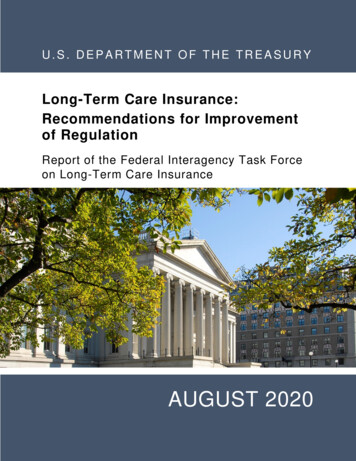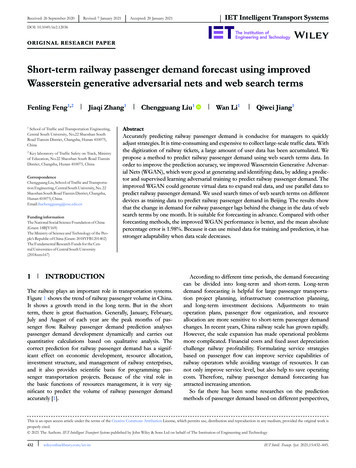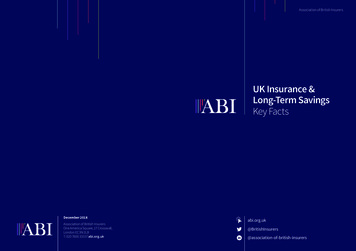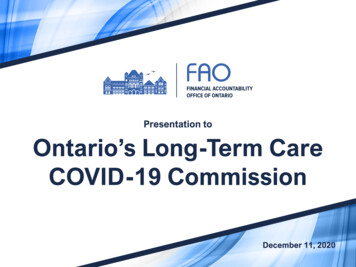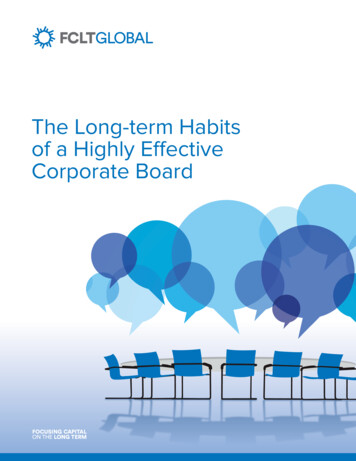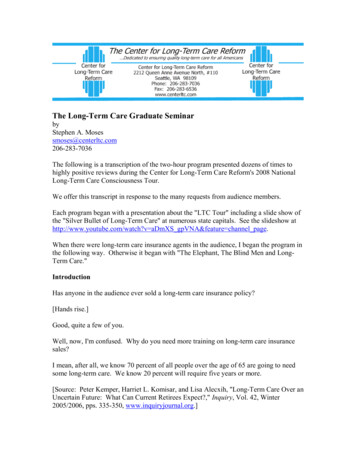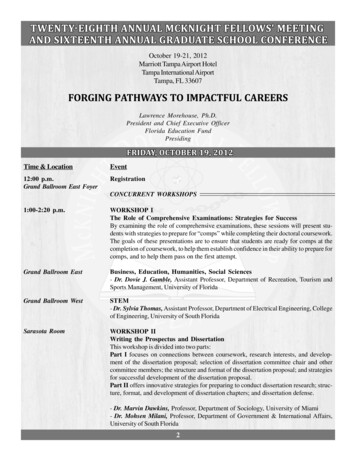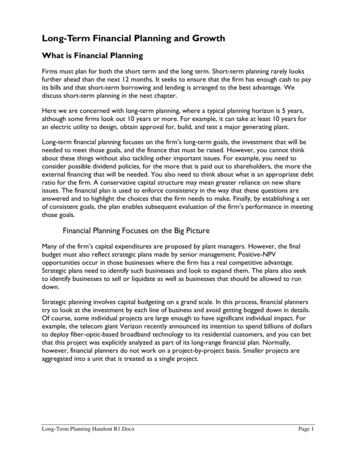
Transcription
Long-Term Financial Planning and GrowthWhat is Financial PlanningFirms must plan for both the short term and the long term. Short-term planning rarely looksfurther ahead than the next 12 months. It seeks to ensure that the firm has enough cash to payits bills and that short-term borrowing and lending is arranged to the best advantage. Wediscuss short-term planning in the next chapter.Here we are concerned with long-term planning, where a typical planning horizon is 5 years,although some firms look out 10 years or more. For example, it can take at least 10 years foran electric utility to design, obtain approval for, build, and test a major generating plant.Long-term financial planning focuses on the firm’s long-term goals, the investment that will beneeded to meet those goals, and the finance that must be raised. However, you cannot thinkabout these things without also tackling other important issues. For example, you need toconsider possible dividend policies, for the more that is paid out to shareholders, the more theexternal financing that will be needed. You also need to think about what is an appropriate debtratio for the firm. A conservative capital structure may mean greater reliance on new shareissues. The financial plan is used to enforce consistency in the way that these questions areanswered and to highlight the choices that the firm needs to make. Finally, by establishing a setof consistent goals, the plan enables subsequent evaluation of the firm’s performance in meetingthose goals.Financial Planning Focuses on the Big PictureMany of the firm’s capital expenditures are proposed by plant managers. However, the finalbudget must also reflect strategic plans made by senior management. Positive-NPVopportunities occur in those businesses where the firm has a real competitive advantage.Strategic plans need to identify such businesses and look to expand them. The plans also seekto identify businesses to sell or liquidate as well as businesses that should be allowed to rundown.Strategic planning involves capital budgeting on a grand scale. In this process, financial plannerstry to look at the investment by each line of business and avoid getting bogged down in details.Of course, some individual projects are large enough to have significant individual impact. Forexample, the telecom giant Verizon recently announced its intention to spend billions of dollarsto deploy fiber-optic-based broadband technology to its residential customers, and you can betthat this project was explicitly analyzed as part of its long-range financial plan. Normally,however, financial planners do not work on a project-by-project basis. Smaller projects areaggregated into a unit that is treated as a single project.Long-Term Planning Handout R1.DocxPage 1
At the beginning of the planning process, the corporate staff might ask each division to submitthree alternative business plans covering the next 5 years:1: A best-case or aggressive growth plan calling for heavy capital investment and rapidgrowth of existing markets.2: A normal growth plan in which the division grows with its markets but notsignificantly at the expense of its competitors.3: A plan of retrenchment if the firm’s markets contract. This is planning for leaneconomic times.The plan will contain a summary of capital expenditures, working capital requirements, as wellas strategies to raise funds for these investments.Growth as a Financial Management GoalWhy Build Financial Plans?Firms spend considerable energy, time, and resources building elaborate financial plans. Whatdo they get for this investment?Examining InteractionsContingency PlanningPlanning is not just forecasting. Forecasting concentrates on the most likely outcomes, butplanners need to worry about unlikely events as well as likely ones. If you think ahead aboutwhat could go wrong, then you are less likely to ignore the danger signals and you can respondfaster to trouble.Companies have developed a number of ways of asking ―what-if‖ questions about bothindividual projects and the overall firm. For example, managers often work through theconsequences of their decisions under different scenarios. One scenario might envisage highinterest rates contributing to a slowdown in world economic growth and lower commodityprices. A second scenario might involve a buoyant domestic economy, high inflation, and a weakcurrency.The idea is to formulate responses to inevitable surprises. What will you do, for example, ifsales in the first year turn out to be 10 percent below forecast? A good financial plan shouldhelp you adapt as events unfold.Considering OptionsPlanners need to think whether there are opportunities for the company to exploit its existingstrengths by moving into a wholly new area. Often they may recommend entering a market for―strategic‖ reasons—that is, not because the immediate investment has a positive net presentvalue but because it establishes the firm in a new market and creates options for possiblyvaluable follow-on investments.Page 2Long-Term Planning Handout R1.Docx
For example, Verizon’s costly fiber-optic initiative would never be profitable strictly in terms ofits current uses, for phone or conventional Internet applications. However, the new technologygives Verizon options to offer services that may be highly valuable in the future, such as therapid delivery of an array of home entertainment services. The justification for the hugeinvestment lies in these potential growth options.Forcing Consistency & Ensuring FeasibilityFinancial plans describe the connections between the firm’s plans for growth and the financingrequirements. For example, a forecast of 25 percent growth might require the firm to issuesecurities to pay for necessary capital expenditures, while a 5 percent growth rate might enablethe firm to finance capital expenditures by using only reinvested profits.Financial plans should help to ensure that the firm’s goals are mutually consistent. For example,the chief executive might say that she is shooting for a profit margin of 10 percent and salesgrowth of 20 percent, but financial planners need to think whether the higher sales growth mayrequire price cuts that will reduce profit margin.Moreover, a goal that is stated in terms of accounting ratios is not operational unless it istranslated back into what that means for business decisions. For example, a higher profit margincan result from higher prices, lower costs, or a move into new, high-margin products. Whythen do managers define objectives in this way? In part, such goals may be a code tocommunicate real concerns. For example, a target profit margin may be a way of saying that inpursuing sales growth, the firm has allowed costs to get out of control.The danger is that everyone may forget the code and the accounting targets may be seen asgoals in themselves. No one should be surprised when lower-level managers focus on the goalsfor which they are rewarded. For example, when Volkswagen set a goal of 6.5 percent profitmargin, some VW groups responded by developing and promoting expensive, high-margin cars.Less attention was paid to marketing cheaper models, which had lower profit margins buthigher sales volume. In 2002 Volkswagen announced that it would de-emphasize its profitmargin goal and would instead focus on return on investment. It hoped that this wouldencourage managers to get the most profit out of every dollar of invested capital.Avoiding SurprisesFinancial Planning has three important uses:Long-Term Planning Handout R1.DocxPage 3
The following steps are used to develop a financial forecast:Financial Planning ModelsFinancial planners often use a financial planning model to help them explore the consequencesof alternative financial strategies. These models range from simple models, such as the onepresented later in this chapter, to models that incorporate hundreds of equations.Financial planning models support the financial planning process by making it easier and cheaperto construct forecast financial statements. The models automate an important part of planningthat would otherwise be boring, time-consuming, and labor-intensive.Programming these financial planning models used to consume large amounts of computer timeand high-priced talent. Microsoft Excel is regularly used to solve complex financial planningproblems.Components of a Financial Planning ModelA completed financial plan for a large company is a substantial document. A smallercorporation’s plan would have the same elements but less detail. For the smallest businesses,financial plans may be entirely in the financial managers’ heads. The basic elements of the planswill be similar, however, for firms of any size.A completed financial plan for a large company is a substantial document. A smallercorporation’s plan would have the same elements but less detail. For the smallest businesses,financial plans may be entirely in the financial managers’ heads. The basic elements of the planswill be similar, however, for firms of any size.Financial plans include three components: inputs, the planning model, and outputs. Let us lookat them in turn.InputsThe inputs to the financial plan consist of the firm’s current financial statements and itsforecasts about the future. Usually, the principal forecast is the likely growth in sales, sincemany of the other variables such as labor requirements and inventory levels are tied to sales.These forecasts are only in part the responsibility of the financial manager. Obviously, themarketing department will play a key role in forecasting sales. In addition, because sales willPage 4Long-Term Planning Handout R1.Docx
depend on the state of the overall economy, large firms will seek forecasting help from firmsthat specialize in preparing macroeconomic and industry forecasts.The Planning ModelThe financial planning model calculates the implications of the manager’s forecasts for profits,new investment, and financing. The model consists of equations relating output variables toforecasts. For example, the equations can show how a change in sales is likely to affect costs,working capital, fixed assets, and financing requirements. The financial model could specify thatthe total cost of goods produced may increase by 80 cents for every 1 increase in total sales,that accounts receivable will be a fixed proportion of sales, and that the firm will need toincrease fixed assets by 8 percent for every 10 percent increase in sales.OutputsThe output of the financial model consists of financial statements such as income statements,balance sheets, and statements describing sources and uses of cash. These statements are calledpro formas, which means that they are forecasts based on the inputs and the assumptions builtinto the plan. Usually the output of financial models also includes many of the financial ratios wediscussed in the last chapter. These ratios indicate whether the firm will be financially fit andhealthy at the end of the planning period.The Plug MethodGourmet Coffee Inc.Balance SheetDecember 31, 2009Assets1,000Total1,000Income StatementFor Year Ended December 31, 000Net Income400Initial AssumptionsRevenues will grow at 15%All items are tied directly to sales, and the current relationships are optimalConsequently, all other items will also grow at 15%Pro Forma Income Statement Year Ended 2010Revenues2,300Costs1,840Net Income460Long-Term Planning Handout R1.DocxPage 5
Pro Forma Balance SheetYear Ended 2010Case IAssetsDebtDividends are the plug variable, so equity increases at 15%Dividends 460 – 90 370 dividends paidCase IITotalAssetsDebt is the plug variable and no dividends are paidDebt 1,150 – 1060 90Repay 400 – 90 310 in debtPage 6EquityTotalDebtEquityTotalTotalLong-Term Planning Handout R1.Docx
We will learn about other forecasting techniques using the following example.Maggie Taylor is the financial manager of Synapse Enzymes (SE), a New Jersey producer of specializedenzymes for use in cellulosic ethanol production, and must prepare a financial forecast for 2010. SE's2009 sales were 2 billion, and the marketing department is forecasting a 25 percent increase for 2010.Eduard Buchner, SE’s CEO has directed Maggie to prepare a forecast assuming the company is at fullcapacity and another assuming current production is less than full capacity. The 2009 financialstatements, plus some other data, are shown below.Table SE-1 2009 Income Statement (in millions)Sales 2,000.00Variable Costs1,200.00Fixed CostsEBIT700 100.00Interest20EBT 80.00Taxes (40%) 32.00Net Income 48.00Dividends (40%) 19.20Additions to Retained Earnings 28.80Table SE-2 2009 Balance Sheet (in millions)Cash and Securities 20.00Accounts Receivable 240.00Inventories 240.00Total Current Assets 500.00Net Fixed Assets 500.00Total Assets 1,000.00Accounts Payable and Accruals 100.00Notes Payable 100.00Total Current Liabilities 200.00Long Term Debt 100.00Common Stock 500.00Retained Earnings 200.00Total Liabilities and Equity 1,000.00Long-Term Planning Handout R1.DocxPage 7
Table SE-3 Key Ratios (SE & Industry)2009RatioSEIndustry FormulasProfit ry turnover8.3311.00Fixed asset Current ratio2.503.00NOPAT 60.00EBIT(1-T)NOWC 400.00CA – (A/P & Accruals)Total Net Operating Capital 900.00NOWC NFANOPAT/Sales3.00%5.00%Net Operating Capital / Sales45.00%35.00%Return on Invested Capital (NOPAT/Capital) 6.67%14.00%You were recently hired as a Financial Analyst reporting to Ms. Taylor. Your responsibilitiesinclude assisting in the development of the forecast. She asked you to begin by answering thefollowing set of questions.Table SE-4 Forecast InputsInputsPercent growth in salesInterest rate on debt (LT & ST)Tax rateDividend Payout Ratio25%10%40%40%Funds will be generated through:Notes Payable:50%Long-Term Debt:50%Page 8Long-Term Planning Handout R1.Docx
1) Assume that SE was operating at full capacity in 2009 with respect to all assets, thereforeall assets must grow proportionally with sales, accounts payable and accruals will alsogrow in proportion to sales, and the 2009 profit margin and dividend payout will bemaintained. Under these conditions, what will the company's financial requirements befor the coming year? Use the EFN equation to answer this question.The EFN Equation is:If EFN is positive, then you must secure additional financing.If EFN is negative, then you have more financing than is needed.Pay off debt.Buy back stock.Buy short-term investments.2) How would changes in these items affect the EFN? (Consider each item separately andhold all other things constant.)Sales increaseIncreases asset requirements, increases EFNDividend payout ratio increasesReduces funds available internally, increases EFNProfit margin increasesIncreases funds available internally, decreases EFNCapital intensity ratio increasesIncreases asset requirements, increases EFNSE begins paying its suppliers sooner.Decreases spontaneous liabilities, increases EFNLong-Term Planning Handout R1.DocxPage 9
3) Now estimate the 2010 financial requirements using the percent of sales method.Project sales based on forecasted growth rate in salesForecast some items as a percent of the forecasted salesTable SE-5 2010 Forecast2009 Income StatementPercent of Sales2010 Forecast(in millions)SalesVariable CostsFixed CostsEBIT 2,000.00 2,500.001,200.000.60001,500.00700.000.3500875.00 100.00 125.0020.0020.00EBT 80.00 105.00Taxes (40%) 32.00 42.00Net Income 48.00 63.00Dividends (40%) 19.20 25.20Additions to Retained Earnings 28.80 37.80InterestPage 10Long-Term Planning Handout R1.Docx
Table SE-5 2010 Forecast (Continued)Percent2009 Balance Sheet (in millions)of SalesCash and Securities 20.000.0100Accounts Receivable 240.000.1200Inventories 240.000.1200Total Current Assets 500.00Net Fixed Assets 500.00Total Assets 625.000.2500 1,000.00 1,250.00Accounts Payable and Accruals 100.00Notes Payable 100.00 100.00Total Current Liabilities 200.00 225.00Long Term Debt 100.00 100.00Common Stock 500.00 500.00Retained Earnings 200.00 237.80 1,000.00 1,062.80Total Liabilities and Equity0.0500Required assets 1,250.00Specified sources of financing 1,062.80External funds needed (EFN) 187.20SE has a choice when considering other itemsLong-Term Planning Handout R1.DocxPage 11
We assumed:Each type of asset, as well as payables, accruals, and fixed and variable costs, will be the samepercent of sales in 2010 as in 2009The payout ratio is held constant at 40 percentExternal funds needed are financed 50 percent by notes payable and 50 percent by long-termdebt (no new common stock will be issued)All debt carries an interest rate of 10 percentInterest expenses should be based on the average of the beginning and ending debt values.Interest expense is actually based on the daily balance of debt during theyear.There are three ways to approximate interest expense. Base it on:Debt at end of yearDebt at beginning of yearAverage of beginning and ending debtBasing Interest Expense on Debt at End of YearWill over-estimate interest expense if debt is added throughout the yearinstead of all on January 1.Causes circularity called financial feedback: more debt causes more interest,which reduces net income, which reduces retained earnings, whichcauses more debt, etc.Basing Interest Expense on Debt at the Beginning of YearWill under-estimate interest expense if debt is added throughout the yearinstead of all on December 31.But doesn’t cause problem of circularityBasing Interest Expense on Average of Beginning and Ending DebtWill accurately estimate the interest payments if debt is added smoothlythroughout the year.But has problem of circularity.Page 12Long-Term Planning Handout R1.Docx
Table SE-6 2010 ForecastPercent2009 Income Statementof Sales(in millions)FromTable SE-5Without EFNSales 2,000.00Variable Costs20102010ForecastFeedback1st PassForecastFeedback2nd Pass 2,500.00 2,500.00 000.3500875.00875.00875.00 100.00 125.00 125.00 125.0020.0020.0029.53EBT 80.00 105.00 95.47Taxes (40%) 32.00 42.00 38.19Net Income 48.00 63.00Dividends (40%) 19.20 25.20Additions to Retained Earnings 28.80 37.80Fixed CostsEBITInterest2009 Balance Sheet(in millions)Cash and Securities 20.000.0100 25.00 25.00 25.00Accounts Receivable 240.000.1200 300.00 300.00 300.00Inventories 240.000.1200 300.00 300.00 300.00 625.00 625.00 625.00 625.00 625.00 625.00 1,250.00 1,250.00 1,250.00 125.00 125.00 125.00Total Current AssetsNet Fixed Assets 500.00 500.000.2500Total Assets 1,000.00Accounts Payable and Accruals 100.00Notes Payable 100.00 100.00 200.00 225.00Long Term Debt 100.00 100.00Common Stock 500.00 500.00 500.00 500.00Retained Earnings 200.00 237.80 234.43 234.37 1,000.00 1,062.80 1,246.63 1,249.94Required assets 1,250.00 1,250.00 1,250.00Specified sources of financing 1,062.80 1,246.63 1,249.94External funds needed (EFN) 187.20 3.37 0.06Total Current LiabilitiesTotal Liabilities and EquityLong-Term Planning Handout R1.Docx0.0500 93.60 193.60 1.68 318.60 93.60 193.60 195.28 320.28 1.68 195.28Page 13
4) Why does the percent of sales approach produce a somewhat different EFN than theequation approach? Which method provides the more accurate forecast?Equation method assumes a constant profit margin.Pro forma method is more flexible. More important, it allowsdifferent items to grow at different rates.5) Calculate SE's forecasted ratios, and compare them with the company's 2009 ratios andwith the industry averages. Calculate SE’s forecasted free cash flow and return oninvested capital (ROIC).Table SE-7 2010 Forecast Ratios20092010RatioFormulasKey RatiosSEIndustry2nd PassProfit .0043.80Inventory turnover8.3311.008.33Fixed asset IE5.009.404.23Current ratio2.503.001.95NOPAT 60.00 75.00EBIT(1-T)NOWC 400.00 500.00CA – (A/P & Accruals)Total Net Operating Capital 900.00 1,125.00 NOWC NFANOPAT/Sales3.00%5.00%3.00%Net Operating Capital / Sales 45.00%35.00%45.00%ROIC (NOPAT/Capital)14.00%6.67%Investment in CapitalPage 146.67% 225.00Long-Term Planning Handout R1.Docx
Table SE-8 2010 Forecast Free Cash Flows and Other InformationForecastFree Cash Flow CalculationNOPAT20092010100(1 – 0.40) 125(1 – 0.40)Net operating working capital(NOWC)500 – 100 625 - 125Total Operating Capital400 500 500 625Investment in Capital 1,125 - 900FCF 75 - 225Return on Invested Capital(NOPAT/Capital)Industry14.00%Remember Cash Flow from Assets for Fin 311CFA OCF – Net Capital spending – NWCOperating cash flow (OCF) EBIT Dep – Taxes EBIT(1 – T) DepNet Capital Spending NFAEnd – NFABeg Dep NOWC NOWCEnd - NOWCBeg6) Based on comparisons between SE's days sales outstanding (DSO) and inventory turnoverratios with the industry average figures, does it appear that SE is operating efficiently withrespect to its inventory and accounts receivable? Suppose SE were able to bring theseratios into line with the industry averages. What effect would this have on its EFN and itsfinancial ratios? What effect would this have on free cash flow and ROIC?Long-Term Planning Handout R1.DocxPage 15
Table SE-9 2010 Forecast with Ratio ImprovementsRatio ImprovementsDSO32.00Inventory turnover11.002009 Income StatementPercent2010of SalesForecast(in millions)Without EFNFeedback1st PassFeedback2nd PassSales 2,000.00 2,500.00 2,500.00 2,500.00Variable Costs1,200.000.60001,500.001,500.001,500.00Fixed Costs700.000.3500875.00875.00875.00EBIT 100.00 125.00 125.00 125.00Interest20.00EBT 80.00 105.00 103.29Taxes (40%) 32.00 42.00 41.31Net Income 48.00 63.00 61.97Dividends (40%) 19.20 25.20 24.79Additions to Retained Earnings 28.80 37.80 37.1820.002009 Balance SheetPercent(in millions)of SalesCash and Securities 20.00Accounts Receivable25.00 21.7121.71 25.00 25.00 240.00 219.18 219.18Inventories 240.00 227.27 227.27Total Current Assets 500.00 471.45 471.45Net Fixed Assets 500.00 625.00 625.00Total Assets 1,000.00 1,096.45 1,096.45Accounts Payable and Accruals 100.00 125.00 125.00Notes Payable 100.00 100.00Total Current Liabilities 200.00 225.00Long Term Debt 100.00 100.00Common Stock 500.00 500.00 500.00Retained Earnings 200.00 237.80 237.18Total Liabilities and Equity 1,000.00 1,062.80 1,096.44Required assets 1,096.45 1,096.45Specified sources of financing 1,062.80 1,096.44External funds needed (EFN) 33.65 0.01Page 160.0100 21.680.25000.0500 125.00 16.83 0.30 117.13 242.13 16.83 0.30 117.13Long-Term Planning Handout R1.Docx
Table SE-10 2010 Key Ratio Forecast20092010RatioKey RatiosSEIndustry2nd Pass FormulasProfit .0032.00Inventory turnover8.3311.0011.00Fixed asset IE5.009.405.76Current ratio2.503.001.95NOPAT 60.00 75.00EBIT(1-T)NOWC 400.00 346.45CA – (A/P & Accruals)Total Net Operating Capital 900.00 971.45NOWC NFANOPAT/Sales3.00%5.00%3.00%Net Operating Capital / Sales 45.00%35.00%38.86%ROIC (NOPAT/Capital)14.00%7.72%6.67%Investment in CapitalLong-Term Planning Handout R1.Docx 71.45Page 17
Table SE-11 2010 Free Cash Flow and Other ForecastsForecastFree Cash FlowNOPAT2009100(1 – 0.40) 2010 125(1 – 0.40)Net operating working capital(NOWC)500 – 100 471.45 - 125Total Operating Capital400 500 346.45 625Investment in Capital 971.45 - 900FCF 75 – 71.45Return on Invested Capital(NOPAT/Capital)Industry14.00%7) In addition to improving the ratios considered above what if SE was able to control Sellingand Admin Cost? Specifically, what if fixed costs were decreased to 33 percent of sales?What effect would this have on its EFN and its financial ratios? What effect would thishave on free cash flow and ROIC?Page 18Long-Term Planning Handout R1.Docx
Table SE-12 2010 Forecast with Ratio Improvements & Cost ReductionRatio & Cost ImprovementsDSO:32.00Inventory turnover:11.00Fixed Costs:33%Percent2009 Income Statementof Sales(in millions)2010 ForecastWithout EFNFeedbackWith EFNFeedbackWith EFNSales 2,000.00 2,500.00 2,500.00 2,500.00Variable Costs1,200.000.60001,500.001,500.001,500.00Fixed Costs700.000.3300825.00825.00EBIT 100.00 175.00 175.00Interest20.00EBT 80.00 154.20Taxes (40%) 32.00 61.68Net Income 48.00 92.52Dividends (40%) 19.20 37.01Additions to Retained Earnings 28.80 55.51 20.78 20.8020.80Percent2009 Balance Sheet (in millions)of SalesCash and Securities 20.00Accounts Receivable0.0100 25.00 25.00 25.00 240.00 219.18 219.18 219.18Inventories 240.00 227.27 227.27 227.27Total Current Assets 500.00 471.45 471.45 471.45Net Fixed Assets 500.00 625.00 625.00 625.00Total Assets 1,000.00 1,096.45 1,096.45 1,096.45Accounts Payable and Accruals 100.00 125.00 125.00 125.00Notes Payable 100.00 100.00Total Current Liabilities 200.00 225.00Long Term Debt 100.00 100.00Common Stock 500.00 500.00Retained Earnings 200.00Total Liabilities and Equity 1,000.000.25000.0500 7.83 107.83 0.14 232.83 7.83 107.83 500.00 107.97 232.97 0.14 107.97 500.00 255.51 1,080.80 1,096.17 1,096.45Required assets 1,096.45Specified sources of financing 1,096.45External funds needed (EFN) 0.01Long-Term Planning Handout R1.DocxPage 19
Table SE-13 2010 Key Ratio Forecast20092010RatioFormulasKey RatiosSEIndustry2nd PassProfit 2.0032.00Inventory turnover8.3311.0011.00Fixed asset IE5.009.408.41Current ratio2.503.002.02NOPAT 60.00 105.00EBIT(1-T)NOWC 400.00 346.45CA – (A/P & Accruals)Total Net Operating Capital 900.00 971.45NOWC NFANOPAT/Sales3.00%5.00%4.20%Net Operating Capital / Sales 45.00%35.00%38.86%ROIC (NOPAT/Capital)14.00%10.81%Investment in CapitalPage 206.67% 71.45Long-Term Planning Handout R1.Docx
Table SE-14 2010 Free Cash Flow and Other ForecastsForecastFree Cash Flow20092010 60.00 105.00 175(1 – 0.40)Net operating working capital(NOWC)500 – 100 400.00 346.45 471.45 - 125Total Operating Capital400 500 900.00 971.45 346.45 625Investment in Capital 71.45 971.45 - 900FCF 33.55 105 – 71.45NOPATReturn on Invested Capital(NOPAT/Capital)Long-Term Planning Handout R1.Docx100(1 – 0.40) 10.81%Industry14.00%Page 21
8) Suppose you now learn that SE's 2009 receivables and inventories were in line withrequired levels, given the firm's credit and inventory policies, but that excess capacityexisted with regard to fixed assets. Specifically, fixed assets were operated at only 75percent of capacity.What level of sales could have existed in 2009 with the available fixed assets?Effect of Excess CapacitySuppose in 2009 fixed assets had been operated at only 75% of capacity?Capacity Sales Actual Sales/% of CapacityHow would the existence of excess capacity in fixed assets affect the additional funds neededduring 2010?Forecasted sales are less than this, so no new fixed assets are needed.Table SE-15Previously forecasted EFN 187.20 From Table SE-6Previously forecasted addition to fixed assets 125.00 From Table SE-6EFN if there is excess capacity 62.20If Sales went up to 3,000, not 2500, what would the F.A. requirement be?Target Ratio Fixed Assets/ Capacity SalesTarget Ratio Target Ratio Change in FA Change in FA Change in CA Change in CL Change in R/E EFN Page 22Long-Term Planning Handout R1.Docx
9) The relationship between sales and the various types of assets is important in financialforecasting. The percent of sales approach, under the assumption that each asset itemgrows at the same rate as sales, leads to an EFN forecast that is reasonably close to theforecast using the EFN equation. Explain how each of the following factors would affectthe accuracy of financial forecasts based on the EFN equation:Economies of scale in the use of assetsEconomies of scale: leads to less-than-proportional asset increases.Lumpy assets.Lumpy assets: leads to large periodic EFN requirements, recurring excess capacity.External Financing and GrowthTable SE-15 shows that at low sales growth rates, SE will have a surplus of cash. When thegrowth rate is 6.88 percent, Se requires external funds.Table SE-15Sales Growth Increase FA Add %25037.830%30039.635%35041.4Graph 00.000%5%10%15%Add R/ELong-Term Planning Handout R1.Docx20%25%30%35%Increase FAPage 23
Internal and Sustainable Growth RatesThe internal growth rate is the maximum growth a firm can be achieved with internallygenerated funds. The equation is:For SE:Determinants of GrowthProfit MarginDividend PolicyFinancial PolicyTotal Asset TurnoverPage 24Long-Term Planning Handout R1.Docx
Financial planning models support the financial planning process by making it easier and cheaper to construct forecast financial statements. The models automate an important part of planning that would otherwise be boring, time-consuming, and labor-intensive. Programming these financial planning models used to consume large amounts of computer .



